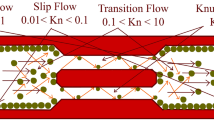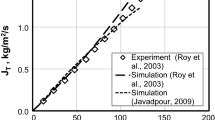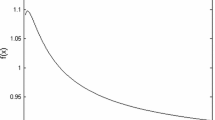Abstract
Simulation of fluid flow in tight rocks, such as shale gas reservoirs, has been a challenging task because of the coexistence of various flow regimes, including the continuum flow, slippage, transition flow, and Knudsen diffusion within the porous structure. Currently, both numerical and analytical methods have been applied to address this issue. In this paper, we have extended the application of most widely used analytical solution for single uniform capillary proposed by Beskok and Karniadakis (Microscale Thermophys Eng 3(1):43–77,1999) to the porous media. The porous structure is represented by a bundle of tortuous capillary tubes with different diameters. Fractal theory is applied to mathematically express the capillary diameter distribution and their tortuosity. For shale gas and coal seam gas formations where adsorption gas is present, the effect of surface diffusion is also included in the analytical solution. Thus, the presented analytical model has allowed us to study the effect of pore size distribution, fractal dimensions for pore size and tortuosity, porosity, surface diffusivity and Langmuir parameters on flow processes. Experimental data from 100 tight gas sand samples and one shale sample, with equivalent liquid permeability ranging from nanodarcy to millidarcy, are used to effectively evaluate the application of the analytical model in the study of flow behavior of gas in tight rocks. The results of this study also show that in tight formation, there has been an increase in apparent gas permeability through the life of production by a factor of 2.2.









Similar content being viewed by others
Abbreviations
- A :
-
Total cross section area (\(\hbox {m}^{2}\))
- \(A_\mathrm{p}\) :
-
Total porous area in the cross section (\(\hbox {m}^{2}\))
- b :
-
Langmuir constant (\(\hbox {Pa}^{-1}\))
- \(b_\mathrm{K}\) :
-
Gas slippage factor (Pa)
- C :
-
Free gas concentration (\(\hbox {mol/m}^{3}\))
- \(C_\mathrm{L}\) :
-
Langmuir capacity (\(\hbox {mol/m}^{3}\))
- \(C_\mathrm{s}\) :
-
Adsorbed gas concentration (\(\hbox {mol/m}^{3}\))
- \(\widehat{G}_\mathrm{K}\) :
-
Knudsen diffusivity (\(\hbox {m}^{2}/\hbox {s}\))
- \(\widehat{G}_\mathrm{s}\) :
-
Surface diffusivity (\(\hbox {m}^{2}/\hbox {s}\))
- \(\widehat{G}_\mathrm{s,0}\) :
-
Surface diffusivity at zero loading (\(\hbox {m}^{2}/\hbox {s}\))
- \(\dot{D}_\mathrm{p}\) :
-
Fractal dimension for pore size
- \(\dot{D}_\mathrm{t}\) :
-
Fractal dimension for tortuosity
- \(d_\mathrm{rw}\) :
-
Jump distance in random walk simulation (m)
- \(J_\mathrm{K}\) :
-
Knudsen diffusion flux (\(\hbox {mol}/\hbox {m}^{2}/\hbox {s}\))
- \(J_\mathrm{s}\) :
-
Surface diffusion flux (\(\hbox {mol}/\hbox {m}^{2}/\hbox {s}\))
- \(K_{n}\) :
-
Knudsen number
- \(k_{\infty }\) :
-
Equivalent liquid permeability (\(\hbox {m}^{2}\) or mD)
- \(k_\mathrm{app}\) :
-
Apparent gas permeability (\(\hbox {m}^{2}\) or mD)
- \(k_\mathrm{app,p}\) :
-
Apparent gas permeability of porous flow (\(\hbox {m}^{2}\) or mD)
- \(k_\mathrm{app,s}\) :
-
Apparent gas permeability of surface diffusion (\(\hbox {m}^{2}\) or mD)
- \(k_\mathrm{ratio}\) :
-
Permeability ratio of apparent gas permeability to equivalent liquid permeability
- \(k_\mathrm{B}\) :
-
Boltzmann constant (\(1.3805 \times 10^{-23}\,\hbox {J/K}\))
- \(L_\mathrm{t}\) :
-
Tortuous length of the pore (m)
- \(L_{0}\) :
-
Representative/straight length of the pore (m)
- M :
-
Molecular weight of gas (kg/mol)
- P :
-
Pressure (MPa)
- Q :
-
Mass flow rate through the cross section (kg/s)
- q :
-
Mass flow rate through the single capillary (kg/s)
- R :
-
Molar gas constant (8.314 J/mol/K)
- \(r_{35\,\%}\) :
-
Pore throat radius at 35 % cumulative pove volume during MICP (m)
- T :
-
Temperature (K)
- D :
-
Pore diameter (m)
- \(D_\mathrm{max}\) :
-
Maximum pore diameter (m)
- \(D_\mathrm{min}\) :
-
Minimum pore diameter (m)
- \(\alpha \) :
-
Rarefaction coefficient
- \({\varGamma }\) :
-
Jump frequency of the gas molecules (\(\hbox {s}^{-1}\))
- \(\delta \) :
-
Collision diameter of the gas molecules (m)
- \(\theta \) :
-
Surface coverage on the pore wall (fraction)
- \(\rho _\mathrm{avg}\) :
-
Average gas density in the system (\(\hbox {kg/m}^{3}\))
- \(\mu \) :
-
Dynamics viscosity of the fluid (\(\hbox {Pa}\,\hbox {s}\))
- \(\tau \) :
-
Tortuosity of pore
- \(\phi \) :
-
Porosity, fraction
- \(\lambda \) :
-
Diameter
References
Aguilera, R.: Incorporating capillary pressure, pore throat aperture radii, height above free-water table, and Winland r35 values on Pickett plots. AAPG Bull. 86(4), 605–624 (2002)
Akkutlu, I.Y., Fathi, E.: Multiscale gas transport in shales with local Kerogen heterogeneities. SPE J. 17(04), 1002–1011 (2012)
Ambrose, R.J., Hartman, R.C., Diaz-Campos, M., et al.: Shale gas-in-place calculations part I: new pore-scale considerations. SPE J. 17(01), 219–229 (2012)
Bai, B., Elgmati, M., Zhang, H., et al.: Rock characterization of Fayetteville shale gas plays. Fuel 105, 645–652 (2013)
Beskok, A., Karniadakis, G.E.: Report: a model for flows in channels, pipes, and ducts at micro and nano scales. Microscale Thermophys. Eng. 3(1), 43–77 (1999)
Chalmers, G.R., Bustin, R.M., Power, I.M.: Characterization of gas shale pore systems by porosimetry, pycnometry, surface area, and field emission scanning electron microscopy/transmission electron microscopy image analyses: examples from the Barnett, Woodford, Haynesville, Marcellus, and Doig units. AAPG Bull. 96(6), 1099–1119 (2012)
Chen, Y., Yang, R.: Concentration dependence of surface diffusion and zeolitic diffusion. AIChE J. 37(10), 1579–1582 (1991)
Choi, J.-G., Do, D., Do, H.: Surface diffusion of adsorbed molecules in porous media: Monolayer, multilayer, and capillary condensation regimes. Ind. Eng. Chem. Res. 40(19), 4005–4031 (2001)
Civan, F.: Effective correlation of apparent gas permeability in tight porous media. Transp. Porous Media 82(2), 375–384 (2010)
Civan, F., Rai, C.S., Sondergeld, C.H.: Determining shale permeability to gas by simultaneous analysis of various pressure tests. SPE J. 17(03), 717–726 (2012)
Curtis, M., Ambrose, R., Energy, D., et al.: Structural characterization of gas shales on the micro- and nano-scales. In: Proceedings of Canadian Unconventional Resources and International Petroleum Conference, Calgary, Alberta, Canada (2010)
Curtis, M.E., Cardott, B.J., Sondergeld, C.H., et al.: Development of organic porosity in the Woodford Shale with increasing thermal maturity. Int. J. Coal Geol. 103, 26–31 (2012)
Do, D.D.: Adsorption Analysis: Equilibria and Kinetics, vol. 2. Imperial College Press, London (1998). (Reprint)
Dongari, N., Sharma, A., Durst, F.: Pressure-driven diffusive gas flows in micro-channels: from the Knudsen to the continuum regimes. Microfluid. Nanofluidics 6(5), 679–692 (2008)
Einstein, A.: Über die von der molekularkinetischen Theorie der Wärme geforderte Bewegung von in ruhenden Flüssigkeiten suspendierten Teilchen. Ann. Phys. 322(8), 549–560 (1905)
Ertekin, T., King, G.A., Schwerer, F.C.: Dynamic gas slippage: a unique dual-mechanism approach to the flow of gas in tight formations. SPE Form. Eval. 1(1), 43–52 (1986)
Etminan, S.R., Javadpour, F., Maini, B.B., et al.: Measurement of gas storage processes in shale and of the molecular diffusion coefficient in kerogen. Int. J. Coal Geol. 123, 10–19 (2014)
Fathi, E., Akkutlu, I.Y.: Matrix heterogeneity effects on gas transport and adsorption in coalbed and shale gas reservoirs. Transp. Porous Media 80(2), 281–304 (2009)
Feder, J.: Fractals. Plenum, New York (1988). (Reprint)
Freeman, C., Moridis, G., Blasingame, T.: A numerical study of microscale flow behavior in tight gas and shale gas reservoir systems. Trans. Porous Media 90(1), 253–268 (2011)
Gad-el-Hak, M.: The MEMS Handbook. CRC, Boca Raton (2002)
He, Y.-L., Tao, W.-Q.: Multiscale simulations of heat transfer and fluid flow problems. J. Heat Transf. 134(3), 031018 (2012)
Heid, J., McMahon, J., Nielsen, R., et al.: Study of the permeability of rocks to homogeneous fluids. In: Proceedings of Drilling and Production Practice, New York, New York (1950)
Higashi, K., Ito, H., Oishi, J.: Surface diffusion phenomena in gaseous diffusion, (I) surface diffusion of pure gas. J. Atomic Energy Soc. Jpn. 5, 846–853 (1963)
Hirschfelder, J.O., Curtiss, C.F., Bird, R.B., et al.: Molecular Theory of Gases and Liquids, vol. 26. Wiley, New York (1954). (Reprint)
Javadpour, F.: Nanopores and apparent permeability of gas flow in mudrocks (shales and siltstone). J. Can. Pet. Technol. 48(8), 16–21 (2009)
Javadpour, F., Fisher, D., Unsworth, M.: Nanoscale gas flow in shale gas sediments. J. Can. Pet. Technol. 46(10), 55–61 (2007)
Johnson, P.K.: A Method for Calculating Viscosity and Thermal Conductivity of a Helium-Xenon Gas Mixture. Paper No. NASA CR-2006–214394 (2006)
Jones, F.O., Owens, W.: A laboratory study of low-permeability gas sands. J. Pet. Technol. 32(09), 1631–1640 (1980)
Kadono, R., Kiefl, R., Brewer, J., et al.: Quantum diffusion of muonium in GaAs. Hyperfine Interact. 64(1–4), 635–640 (1991)
Kang, S.M., Fathi, E., Ambrose, R.J., et al.: Carbon dioxide storage capacity of organic-rich shales. SPE J. 16(04), 842–855 (2011)
Kapoor, A., Yang, R.: Surface diffusion on energetically heterogeneous surfaces—an effective medium approximation approach. Chem. Eng. Sci. 45(11), 3261–3270 (1990)
King, D.A.: Surface diffusion of adsorbed species: a review. J. Vac. Sci. Technol. 17(1), 241–247 (1980)
Klinkenberg, L.J.: The permeability of porous media to liquids and gases. In: Proceedings of Drilling and Production Practice, New York, New York (1941)
Knudsen, M.: The law of the molecular flow and viscosity of gases moving through tubes. Ann. Phys. 28, 75–130 (1909)
Koponen, A., Kataja, M., Timonen, J.: Tortuous flow in porous media. Phys. Rev. E 54(1), 406 (1996)
Kowalczyk, P., Gauden, P.A., Terzyk, A.P., et al.: Microscopic model of carbonaceous nanoporous molecular sieves-anomalous transport in molecularly confined spaces. Phys. Chem. Chem. Phys. 12(37), 11351–11361 (2010)
Krohn, C.E.: Fractal measurements of sandstones, shales, and carbonates. J. Geophys. Res. Solid Earth (1978–2012) 93(B4), 3297–3305 (1988)
Kuila, U., Prasad, M., Derkowski, A., et al.: Compositional controls on mudrock pore-size distribution: an example from Niobrara formation. In: Proceedings of SPE Annual Technical Conference and Exhibition, San Antonio, Texas, USA (2012)
Kuila, U., Prasad, M., Kazemi, H.: Application of Knudsen flow in modeling gas-flow in shale reservoirs. In: Proceedings of 9th Biennial International Conference and Exposition on Petroleum Geophysics. Hyderabad (2013)
Langmuir, I.: The adsorption of gases on plane surfaces of glass, mica and platinum. J. Am. Chem. Soc. 40(9), 1361–1403 (1918)
Lee, A.L., Gonzalez, M.H., Eakin, B.E.: The viscosity of natural gases. J. Pet. Technol. 18(08), 997–1000 (1966)
Letham, E.A.: Matrix Permeability Measurements of Gas Shales: Gas Slippage and Adsorption As Sources of Systematic. Bachelor Bachelor Thesis, University of British Columbia (2011)
Li, K., Horne, R.N.: Experimental study and fractal analysis of heterogeneity in naturally fractured rocks. Transp. Porous Media 78(2), 217–231 (2009)
Loyalka, S., Hamoodi, S.: Poiseuille flow of a rarefied gas in a cylindrical tube: solution of linearized Boltzmann equation. Phys. Fluids A Fluid Dyn. (1989–1993) 2(11), 2061–2065 (1990)
Mandelbrot, B.B.: The Fractal Geometry of Nature, vol. 173. Macmillan, London (1983). (Reprint)
Mason, E.A., Malinauskas, A.: Gas Transport in Porous Media: the Dusty-Gas Model, vol. 17. Elsevier, Amsterdam (1983). (Reprint)
Medved, I., Cerny, R.: Surface diffusion in porous media: a critical review. Microporous Mesoporous Mater. 142(2), 405–422 (2011)
Mitchell, B.S.: An Introduction to Materials Engineering and Science for Chemical and Materials Engineers. Wiley, New Jersey (2004). (Reprint)
Miyabe, K., Guiochon, G.: Kinetic study of the mass transfer of bovine serum albumin in anion-exchange chromatography. J. Chromatogr. A 866(2), 147–171 (2000)
Miyabe, K., Guiochon, G.: Measurement of the parameters of the mass transfer kinetics in high performance liquid chromatography. J. Sep. Sci. 26(3–4), 155–173 (2003)
Roy, S., Raju, R., Chuang, H.F., et al.: Modeling gas flow through microchannels and nanopores. J. Appl. Phys. 93(8), 4870–4879 (2003)
Sakhaee-Pour, A., Bryant, S.: Gas permeability of shale. SPE Reserv. Eval. Eng. 15(04), 401–409 (2012)
Sevenster, P.: Diffusion of gases through coal. Fuel 38(4), 403–418 (1959)
Sing, K., Everett, D., Haul, R., et al.: Physical and biophysical chemistry division commission on colloid and surface chemistry including catalysis. Pure Appl. Chem. 57(4), 603–619 (1985)
Smith, D.M., Williams, F.L.: Diffusional effects in the recovery of methane from coalbeds. Soc. Pet. Eng. J. (United States) 24(5), 529–535 (1984)
Sutera, S.P., Skalak, R.: The history of Poiseuille’s law. Ann. Rev. Fluid Mech. 25(1), 1–20 (1993)
Tang, G., Tao, W., He, Y.: Gas slippage effect on microscale porous flow using the lattice Boltzmann method. Phys. Rev. E 72(5), 056301 (2005)
Tsien, H.-S.: Superaerodynamics, mechanics of rarefied gases. J. Aeronaut. Sci. (Institute of the Aeronautical Sciences) 13(12), 653–664 (1946)
Valiullin, R., Kortunov, P., Kärger, J., et al.: Surface self-diffusion of organic molecules adsorbed in porous silicon. J. Phys. Chem. B 109(12), 5746–5752 (2005)
Van den Berg, A., Bromley, S., Flikkema, E., et al.: Molecular-dynamics analysis of the diffusion of molecular hydrogen in all-silica sodalite. J. Chem. Phys. 120(21), 10285–10289 (2004)
Wang, F.P., Reed, R.M.: Pore networks and fluid flow in gas shales. In: Proceedings of SPE Annual Technical Conference and Exhibition, New Orleans, Louisiana (2009)
Xu, P., Yu, B.: Developing a new form of permeability and Kozeny-Carman constant for homogeneous porous media by means of fractal geometry. Adv. Water Resour. 31(1), 74–81 (2008)
Yang, F., Ning, Z., Liu, H.: Fractal characteristics of shales from a shale gas reservoir in the Sichuan Basin, China. Fuel 115, 378–384 (2014)
Yang, R., Sikavitsas, V.: Kinetic theory for predicting multicomponent diffusivities from pure-component diffusivities for surface diffusion and diffusion in molecular sieves. Chem. Eng. Sci. 50(20), 3319–3322 (1995)
Yang, R.T., Fenn, J.B., Haller, G.L.: Modification to the Higashi model for surface diffusion. AIChE J. 19(5), 1052–1053 (1973)
Yi, J., Akkutlu, I.Y., Deutsch, C.V.: Gas transport in bidisperse coal particles: investigation for an effective diffusion coefficient in coalbeds. J. Can. Pet. Technol. 47(10), 20–26 (2008)
Yu, B.: Fractal character for tortuous streamtubes in porous media. Chin. Phys. Lett. 22(1), 158 (2005)
Yu, B.: Analysis of flow in fractal porous media. Appl. Mech. Rev. 61(5), 050801 (2008)
Yu, B., Cheng, P.: A fractal permeability model for bi-dispersed porous media. Int. J. Heat Mass Transf. 45(14), 2983–2993 (2002)
Yu, B., Li, J.: Some fractal characters of porous media. Fractals 9(03), 365–372 (2001)
Zheng, Q., Yu, B., Wang, S., et al.: A diffusivity model for gas diffusion through fractal porous media. Chem. Eng. Sci. 68(1), 650–655 (2012)
Ziarani, A.S., Aguilera, R.: Knudsen’s permeability correction for tight porous media. Transp. Porous Media 91(1), 239–260 (2012)
Acknowledgments
The authors would like to acknowledge Prof. Boming Yu from Huazhong University of Science and Technology, China, for his help in deep understanding of fractal theory.
Author information
Authors and Affiliations
Corresponding author
Rights and permissions
About this article
Cite this article
Yuan, Y., Gholizadeh Doonechaly, N. & Rahman, S. An Analytical Model of Apparent Gas Permeability for Tight Porous Media. Transp Porous Med 111, 193–214 (2016). https://doi.org/10.1007/s11242-015-0589-3
Received:
Accepted:
Published:
Issue Date:
DOI: https://doi.org/10.1007/s11242-015-0589-3




